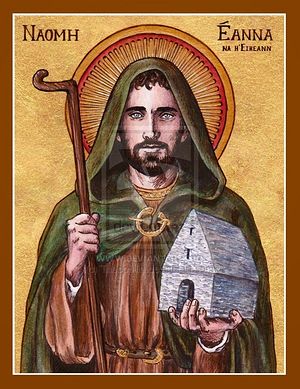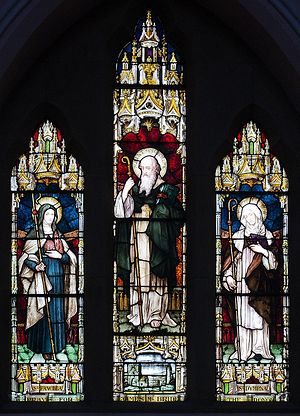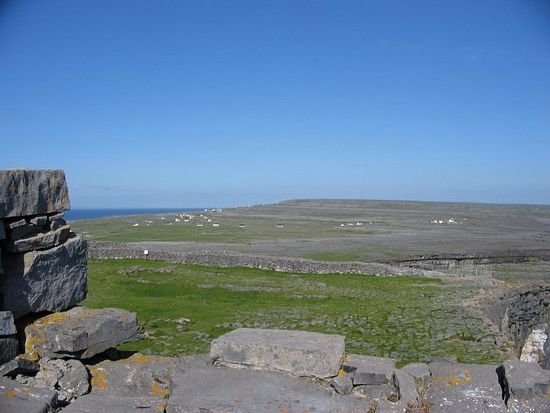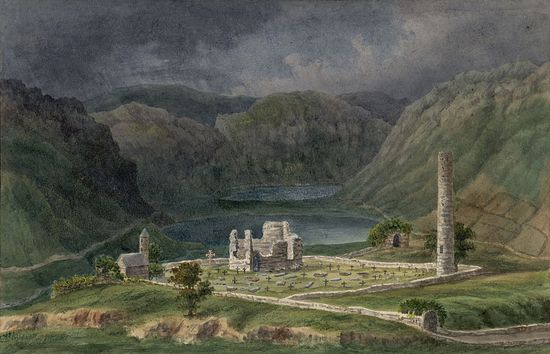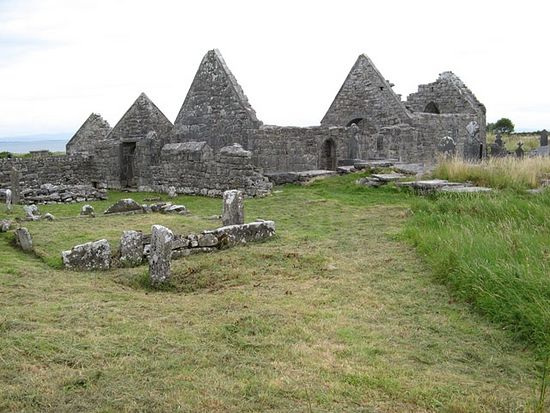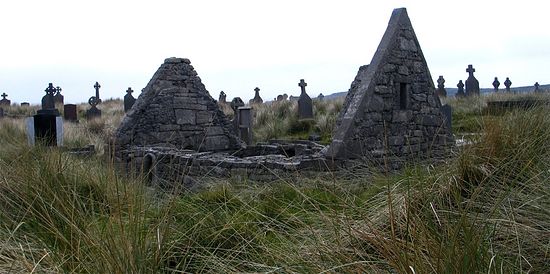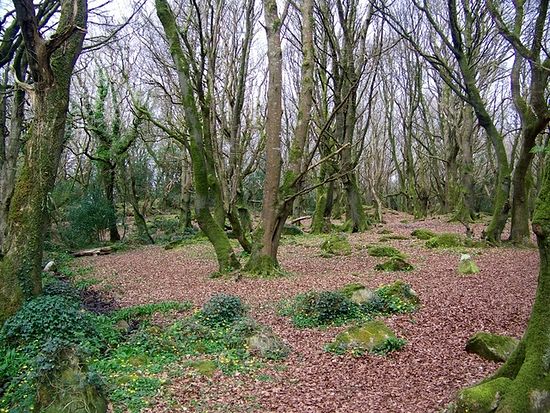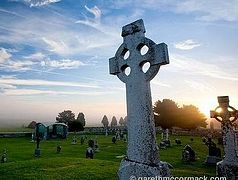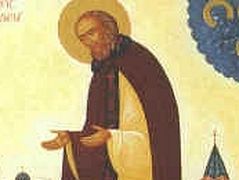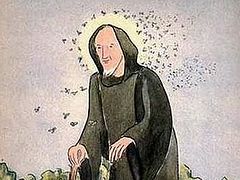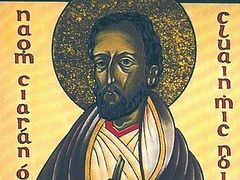Venerable Enda (Enna, Endeus) was born in the mid-fifth century in the present-day County Meath in Ireland and it is said that Enda was the son of a minor ruler in Ulster in Ireland. In his youth he was under the strong influence of his sister St. Fanchea1 who gained fame as a wise abbess and is listed among the saints. As a young man he was a soldier but later gave up a military career, deciding to dedicate all his energies to the service of the Lord and people. He then went to the west of what is now Scotland and obtained an education at the monastery and school called Candida Casa, founded by St. Ninian at Whithorn. It was there, at Whithorn, where he was tonsured monk and ordained priest. Enda is one of the earliest saints of Ireland, so it is presumed that he moved to study in Scotland due to lack of monastic sites in his native land. The experience and monastic tradition, closely linked to monasticism in the East and gained at Candida Casa, contributed to the future achievements of Enda.
So, Enda came back to Ireland and first founded several churches at Drogheda in the Lauth region and soon afterwards—built his first monasteries in the valley of the River Boyne. By 484 the saint had moved far to the west and established his principal monastery on the island of Inishmore (its Irish name: “Arain Mhor”, the big island)—the largest of three islands which make up the group called the Aran Islands, situated in the Atlantic off the Galway coast of what is now the Republic of Ireland (the other two islands are Inishmaan and Inisheer). Today it is situated in County Galway and is washed by the inlet of Galway Bay. The land for this monastery was granted him by his relative, King of Cashel.
In fact, Enda was the founder of the first well-organized monasteries in Ireland and prepared the ground for the great St. Finian of Clonard, another father of Irish monasticism who lived a generation later. The greatest monastery of Enda was, of course, on Inishmore; in fact this little holy island (with a total area of just twelve square miles) always had about ten monasteries, and has been revered by Christians as “an Irish Athos”.
Inishmore grew into a celebrated center of holiness and learning. St. Enda, its first abbot, initially had around 150 disciples, and with time trained and instructed a host of future saints on this island. Such great saints of the Irish Church as Ciaran of Clonmacnoise and Brendan the Navigator were among Enda’s disciples on Inishmore. It was there that such holy men as Sts. Columba of Iona, Finnian of Moville, Finnian of Clonard, Carthage the Elder and Jarlath of Tuam may have studied or stayed at different times. Enda made Inishmore an entirely monastic island, setting up a network of no less than ten monasteries there, the chief of which was called Killeany, which means “church of Enda”. His disciples, in their turn, founded monasteries on the Irish mainland.
The holy Abbot Enda and his brethren led an extremely austere ascetic life, imitating the Desert Fathers of Egypt. Each monastic community comprised a church or chapel with a number of monastic cells. On Inishmore monks practiced manual labor and devoted most of their time to fasting, prayer and studying the Holy Scriptures. Apart from tiny stone ascetic monastic cells, the monks lived in separate caves or isolated sketes, as many of them chose the ascetic traditions of the ancient fathers. Under St. Enda it was not allowed to kindle fire in monastic cells of Inishmore even in very cold weather, the monks’ clothing was very humble, and they normally refrained from any conversations during their meal in the monastery refectory. The diet of Inishmore monks was very simple and consisted of bread, cereals, and water. Fish and milk were a rarity, while wine and meat were a luxury and allowed only in extreme cases (occasionally on great feasts or during illness). St. Enda and many of his close disciples did not taste meat at all. In addition, the climate of Inishmore was too cold to grow fruit.
The brethren slept on the bare ground of their cells or laid down a bundle of straw. They had a flock of sheep which provided them with wool to weave their clothes. They toiled on the land, grew barley and oats, baked bread and did many other things with their own hands. In spite of these austere customs, hundreds of ascetics settled on this holy island, and Inishmore became a shining light of holiness in Western Europe for many centuries. Notwithstanding the coldness of the monastic cells, the ascetics did not feel cold as their hearts were glowing with ardent divine love. A cloud of future missionaries, who studied in this island monastic city, absorbed its spirit of love, community, sanctity and prayer, disseminating this radiant light to many foreign lands that had before been pagan.
The fame of St. Enda spread far and wide. The loving care of the holy abbot was directed not only toward monks, but also at the poor, the oppressed and suffering. According to tradition, he ordered the monks to build “eight places for refuge” on the island, where all who had nowhere else to go could find shelter and care. St. Columba who had visited Inishmore in his early youth was so impressed by its atmosphere that he described it as “the second Rome for pilgrims”, “the Sun of the West” (the Aran Islands lie to the west of the westernmost country of Europe) and witnessed that the glory of Inishmore was so bright that “even the angels of God descended from heaven and worshipped in its churches.” It was said that Columba went into mourning on the day he had to leave Inishmore. For many, Inishmore was in some sense like an image of Paradise. Many wanted it to be the site of their resurrection so they dreamed of being buried on Inishmore.
It is quite possible that for some time St. Enda labored on the island of Arranmore, also called “Aran Island”, off the west coast of present-day Donegal. Venerable Enda who had gathered countless disciples and followers around him, reposed peacefully on his beloved Inishmore in 530. This date is attested by the Irish annals of that time, although some hagiographers suppose that he died much later in the sixth century. The year 530 seems more correct, because, in this case, the saint had lived in Inishmore for some fifty years, reaching about the age of eighty. St. Enda is one of the most venerated sixth-century Irish saints and, together with Finnian of Clonard, is credited with establishing monasticism in the Emerald Island, Ireland. The influence of these two saints spread not only to all Ireland, but even beyond: to England and mainland Europe.
During “the Age of the Saints” Inishmore was nicknamed “the Aran of the Saints”. The holy island was held in such great esteem that in the sixth century the neighboring kings of Munster and Connaught decreed that this group of three islands (now known as the Aran Islands, as mentioned above), including Inishmore, be given independence from both kingdoms. It was a very popular pilgrimage destination in the Middle Ages. In 1081 these islands were attacked by the Vikings and again attacked in the first half of the fourteenth century. In the fifteenth century a Franciscan monastery was built on Inishmore which existed for just over a century. Unfortunately, under Oliver Cromwell in the seventeenth century, many of the Inishmore ruins were barbarously destroyed.
Despite all this, the memory of St. Enda still lives on, especially in Inishmore, where numerous ruins and parts of his early (Orthodox) monasteries and churches survive to this day and attract pilgrims, both Catholic and Orthodox. Some buildings can be traced back to the time of the saint himself. Among the surviving shrines are small sections of monastic walls, remains of towers and other buildings and even tiny “beehive-cells” probably used by monks as a skete. Notable are the remains of “the seven churches” in the west of the island; the remains of Kilronan and Kilmurvey communities; the site of Killeany Monastery in the island’s eastern corner; and, most importantly, the spot called Teaghlach einne (“Enda’s household”), a fine ruined ninth-century church with parts of several high crosses, a distinct altar and other elements, where St. Enda is believed to be buried together with his 120 disciples, awaiting the time of their resurrection.
A holy well in honor of St. Enda (“Tobar Einne”) still exists and is said to have healing properties. It is in Inisheer, another of the three Aran Islands, with annual pilgrimages arranged to it. Another St. Enda’s ancient well can be found at the entrance to the Barna Woods on the mainland coast of Galway near the town of Galway. According to tradition, the saint used to rest in this spot during his travels from his monastery to the mainland of Ireland, and once a spring gushed forth here due to his prayers. It has been known for curative powers, especially against ear and eye complaints. Today St. Enda is the patron saint of the Aran Islands. In fact each of the three islands was a center of monasticism and learning in the early Middle Ages and was home to numerous saints, both men and women. While Egyptian hermits lived in real deserts, Irish hermits found “deserts” in the ocean and labored mostly on islands in the same spirit as the disciples of St. Anthony the Great.
The tiny archipelago’s population is just over 1000 people. It is also famous for its archeological heritage and vegetation, especially flowers. Down the centuries the Aran Islands have attracted a large number of artists and poets, and the Irish language is still spoken by the majority. Among modern sites connected with our saint let us mention a twentieth-century Catholic Church of St. Enda at Tullydrum in Louth, built in the “Hiberno-Romanesque” style. A secondary school in Galway is called “St. Enda’s College”.
Holy Father Enda of Inishmore, pray to God for us!

